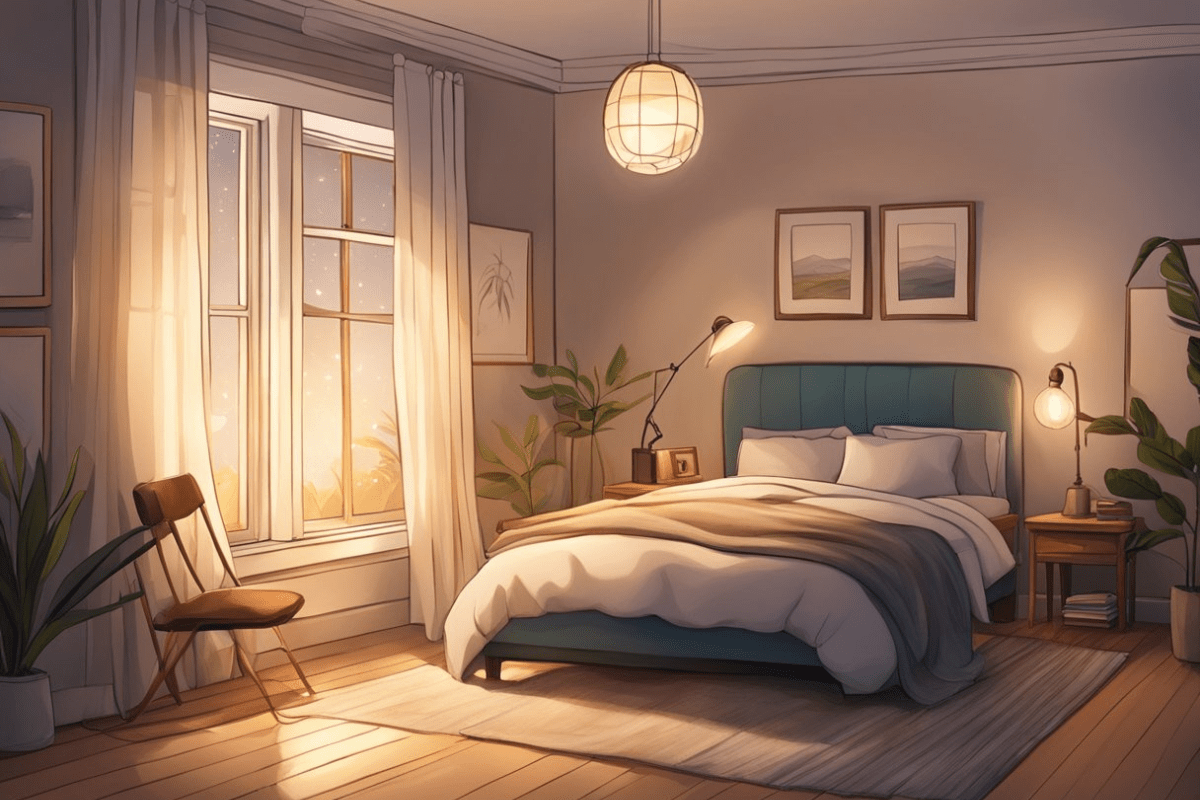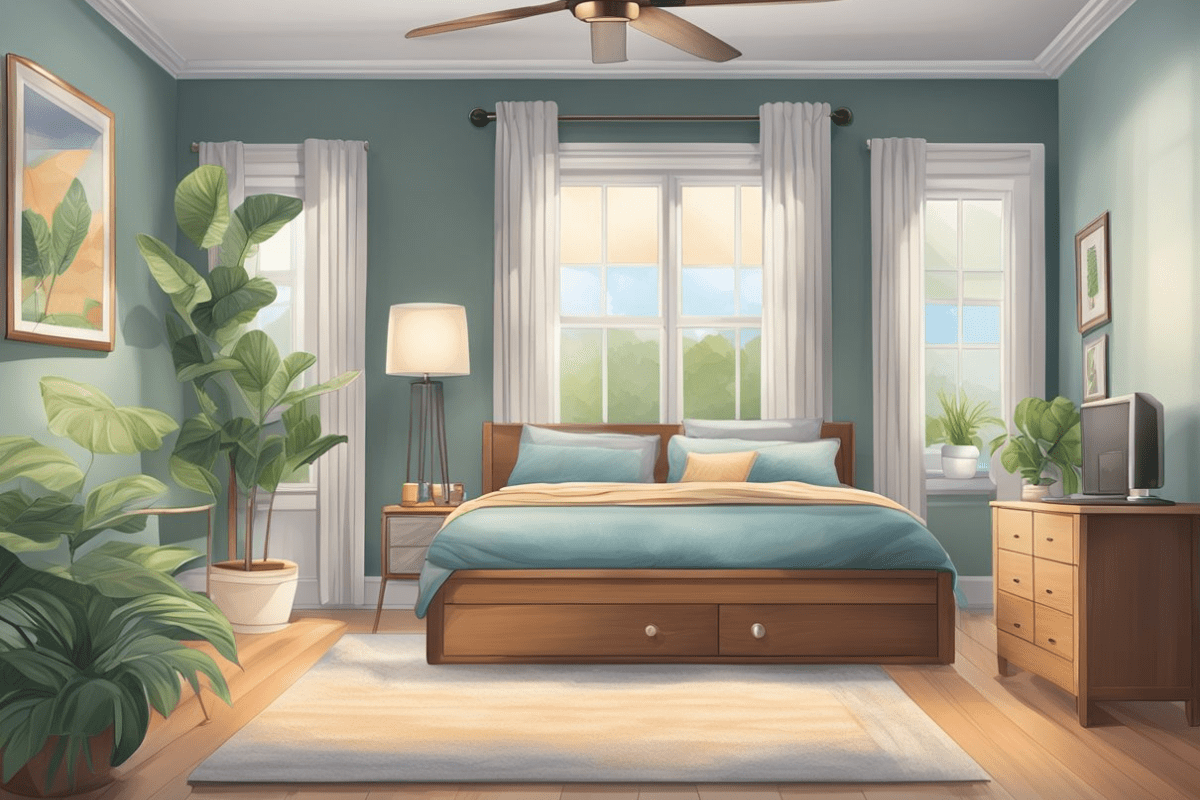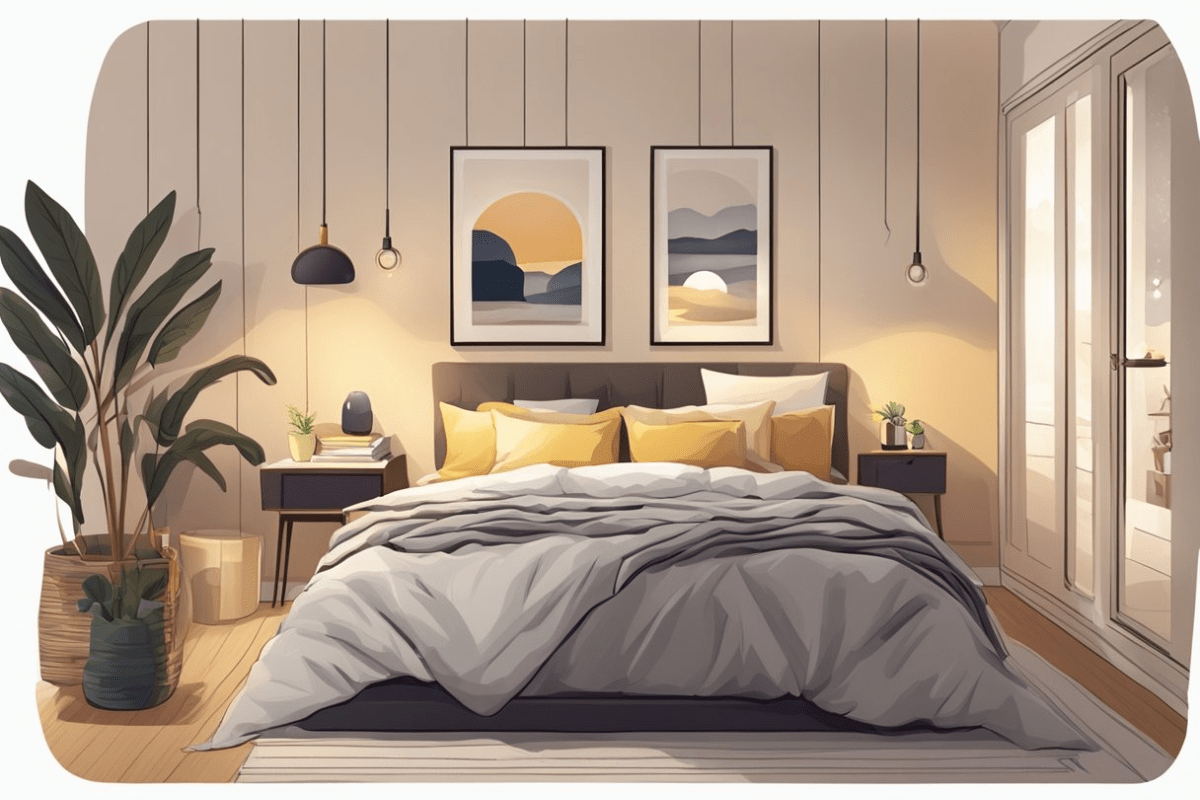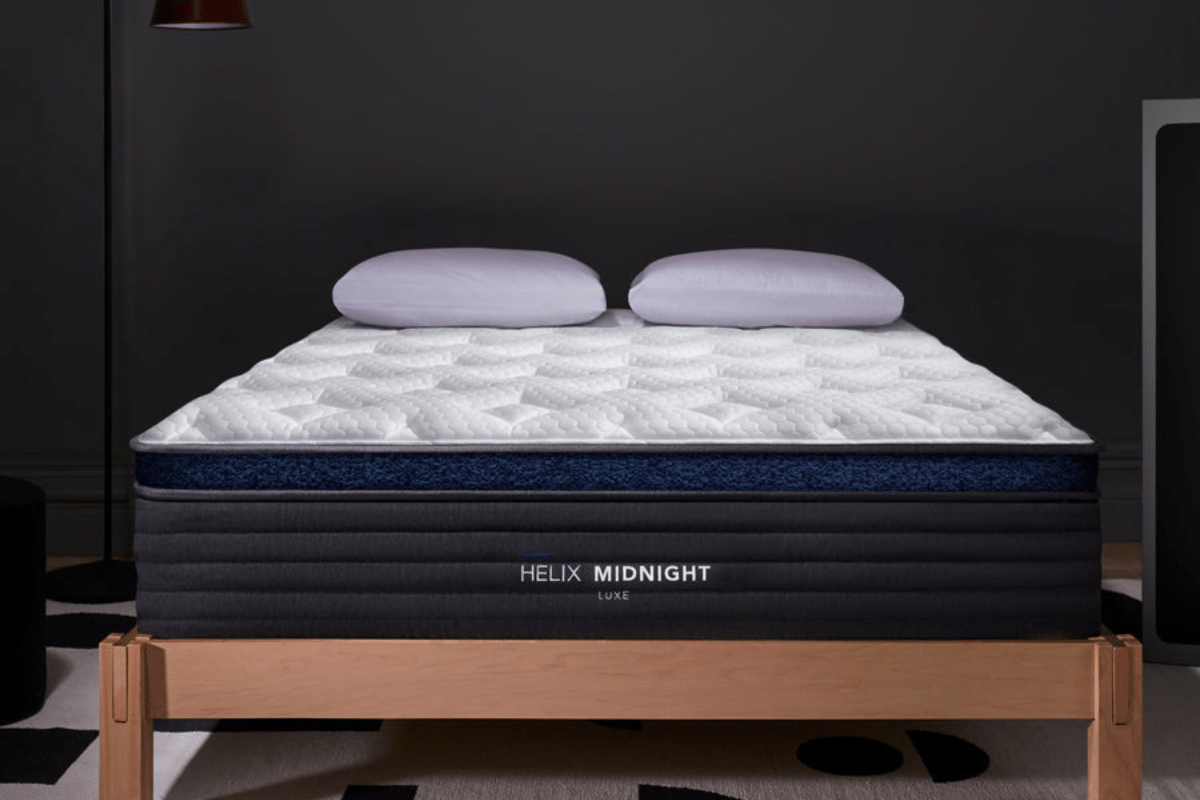A restful night’s sleep is crucial for good health and well-being. The best temperature for sleep is generally between 65 to 68 degrees Fahrenheit (18 to 20 degrees Celsius). This range can create an ideal environment that supports the body’s natural sleep cycles and promotes deeper rest. Temperature can significantly affect sleep quality. Factors like bedroom insulation, humidity, and even personal preferences play a role in determining the optimal sleeping conditions. Adjusting the thermostat or using techniques to cool down the room can lead to better rest and overall health.
Understanding how temperature impacts sleep can help individuals make informed decisions about their sleep environment. Keeping a stable and comfortable temperature not only aids in falling asleep faster but also improves sleep duration and quality.
Key Takeaways
- The ideal sleep temperature is between 65 to 68 degrees Fahrenheit.
- Various factors can influence bedroom temperature and sleep quality.
- Techniques for adjusting room temperature can enhance sleep conditions.
- The best temperature for sleep can be influenced by your mattress choice, as breathable materials like latex and hybrid designs help maintain a cooler sleep environment, while memory foam may retain heat.

The Science of Sleep and Temperature
Temperature plays a significant role in sleep quality. It affects the body’s ability to fall asleep and stay asleep through the night. During sleep, the body undergoes a natural drop in core temperature. This change helps signal that it’s time to rest. A cooler bedroom environment supports this process. Research suggests that the ideal sleeping temperature for most adults is between 60°F and 67°F. Staying within this range promotes deeper and more restorative sleep.
Effects of Extreme Temperatures:
Too Hot: High temperatures can increase wakefulness and reduce slow-wave sleep.
Too Cold: A very cold environment can lead to discomfort, making it hard to relax.
Finding the right temperature also involves personal preferences. Some people may prefer cooler rooms, while others may need slight warmth to feel comfortable. Adjusting bedding and using fans or heaters can help maintain the desired temperature. Soft, breathable fabrics also support better temperature regulation during sleep.
To improve sleep quality, individuals should pay attention to their bedroom environment. A balance in temperature can lead to more restful nights and better overall health. For further insights about the best temperature for sleep, explore research from the Sleep Foundation.
The ideal temperature for sleep plays a crucial role in sleep quality. Different age groups and personal comfort levels can affect what temperature is best for getting restorative rest.
Variations by Age
Temperature preferences can vary significantly with age. Infants typically thrive in cooler environments. The recommended sleeping temperature for babies is around 68°F to 72°F (20°C to 22°C). This range helps prevent overheating, which can be a risk factor for sudden infant death syndrome (SIDS).
As children mature into adults, the optimal sleep temperature shifts. Most experts suggest that adults sleep best in a range of 60°F to 67°F (15.6°C to 19.4°C). Seniors may prefer slightly warmer temperatures, often closer to 68°F to 72°F (20°C to 22°C), due to changes in their metabolism and circulation.
Factors Affecting Bedroom Temperature
Several elements can impact the temperature of a bedroom significantly. Understanding these factors can help ensure a comfortable sleeping environment. The following sections cover seasonal changes, room insulation and ventilation, as well as bedding and sleepwear.
Seasonal Changes
The time of year can greatly influence bedroom temperature. In winter, outside temperatures drop, leading to cooler indoor conditions. This often makes heating essential to maintain comfort. Conversely, summer brings warmer weather. Higher outdoor temperatures can lead to increased indoor heat. Using fans or air conditioning can help control warmth during these months.
Temperature adjustments may also be needed during transitional seasons like spring and fall. Keeping windows open for fresh air can stabilize indoor temperatures while decreasing reliance on heating or cooling systems.
Room Insulation and Ventilation
Insulation plays a vital role in maintaining a consistent bedroom temperature. Well-insulated rooms retain heat during colder months while keeping out excessive heat in warmer months. Poor insulation can lead to temperature fluctuations.
Ventilation is equally important. Proper airflow prevents stuffiness, which can affect sleep quality. Rooms with windows should allow fresh air circulation without letting in too much heat or cold. Ceiling fans can aid in airflow. They create a wind chill effect, making the room feel cooler without actually lowering the temperature. Keeping vents and ducts clean also promotes efficient heating and cooling.
Bedding and Sleepwear Choices
Bedding and sleepwear choices have a direct impact on how comfortable someone feels at night. Light, breathable fabrics like cotton can help regulate body temperature. They prevent overheating while still providing warmth when needed. Heavy blankets may be suitable for colder weather, but they can lead to discomfort in summer. Choosing appropriate bedding helps individuals adapt to seasonal shifts.
Sleepwear should also consider fabric and fit. Loose-fitting garments made from breathable materials keep the body cool. They allow for better air circulation, enhancing the overall sleep experience.
Techniques for Achieving Ideal Sleeping Conditions
Creating the perfect sleep environment involves adjusting the temperature and making specific changes to habits and products. These techniques help enhance sleep quality effectively.
Thermostat Settings
Setting the thermostat to an ideal temperature is crucial for promoting restful sleep. Most experts recommend a bedroom temperature between 60°F and 67°F (15°C to 19°C).
To achieve this, individuals can:
- Use a programmable thermostat: This allows the temperature to adjust automatically based on sleeping schedules.
- Keep windows closed: This prevents outdoor temperature changes from affecting the indoor climate.
- Monitor humidity levels: A humidity level between 30% and 50% contributes to comfort, as excessive humidity can make the room feel warmer.
Regularly checking the thermostat helps ensure that the environment remains conducive to sleep.
Cooling and Heating Products
Utilizing specific products can significantly enhance the temperature comfort of a sleeping area. Here are some effective options:
- Cooling mattress pads or blankets: These can be made from breathable materials that regulate body heat while sleeping.
- Fans: Using a fan can increase airflow and create a cooling effect, even in warmer conditions.
- Space heaters or electric blankets: For colder nights, these products can provide targeted warmth without overheating the entire room.
Investing in quality sleep products allows individuals to maintain their ideal sleep temperature effectively.
Behavioral Adjustments
Changing bedtime habits can also help achieve better sleeping conditions. Important adjustments include:
- Establishing a bedtime routine: Going to bed and waking up at the same time each day helps regulate the body’s internal clock.
- Reducing activities before bed: Avoiding exercise or stimulating activities an hour before sleep promotes relaxation.
- Limiting screen time: The blue light emitted by devices can disrupt sleep patterns, making it wise to set screens aside.
These behavioral changes, combined with temperature adjustments, contribute significantly to better sleep quality.
Health Impacts of Sleep Temperature
Getting enough sleep is essential for maintaining good health and overall well-being. While sleep requirements vary by age, they can also differ from person to person due to lifestyle, health, and other individual factors.
Sleep Needs by Age Group
Each stage of life comes with specific sleep recommendations. Here’s a breakdown of the ideal hours of sleep per day:
- Newborns (0-3 months): 14-17 hours, including naps throughout the day.
- Infants (4-12 months): 12-16 hours, with multiple naps supporting growth and development.
- Toddlers (1-2 years): 11-14 hours, often with at least one daytime nap.
- Children (3-5 years): 10-13 hours, with some still benefiting from naps.
- School-Age Children (6-13 years): 9-11 hours, typically without naps as sleep consolidates at night.
- Teens (14-17 years): 8-10 hours, which is crucial for cognitive function and physical growth.
- Adults (18-64 years): 7-9 hours, supporting energy levels, concentration, and overall health.
- Older Adults (65+ years): 7-8 hours, though sleep may become lighter and more fragmented with age.
Individual Variability
While these guidelines provide a general framework, individual sleep needs can differ. Several factors can influence how much sleep a person requires:
- Lifestyle: High-stress jobs, physical activity, or irregular schedules may require more rest to maintain balance.
- Health Conditions: Chronic illnesses, anxiety, and depression can impact sleep quality and duration.
- Genetics: Some individuals naturally function well on less sleep, while others need more to feel rested.
- Sleep Quality: A person experiencing frequent wake-ups or restless sleep may require longer sleep periods to compensate.
Paying attention to how you feel after different amounts of sleep can help determine your personal needs. Adjusting sleep habits accordingly ensures better energy levels, focus, and long-term health.
When exploring what sleep is, it’s important to recognize the critical role a mattress plays in achieving restful and restorative sleep. A mattress affects spinal alignment, pressure relief, and overall comfort, making it a key factor in sleep quality. Sleeping on an unsupportive or uncomfortable mattress can lead to aches, disrupted sleep, and long-term health issues.
For those looking to upgrade their sleep experience, the Nolah Evolution 15″ is an excellent choice. This premium hybrid mattress combines pressure-relieving foam, cooling technology, and zoned support to accommodate a wide range of sleep preferences. Its design helps promote deeper sleep by reducing motion transfer and maintaining optimal temperature regulation throughout the night.
Choosing the Best King-Size Mattress
If you’re considering a king-size mattress, here are some essential factors to keep in mind:
- Firmness Level: Side sleepers typically prefer softer mattresses for pressure relief, while back and stomach sleepers benefit from firmer support.
- Material Type: Hybrid mattresses, like the Nolah Evolution 15”, blend foam and coils for enhanced support and durability, whereas memory foam provides contouring comfort.
- Cooling Technology: If you tend to overheat at night, opt for a mattress with breathable materials and cooling layers.
- Motion Isolation: Couples should look for a mattress with excellent motion isolation to minimize disturbances from movement.
- Durability and Warranty: A high-quality mattress should last for years, so consider options with strong warranties and durable construction.
Investing in a well-designed mattress ensures better sleep, improving overall health and daily performance. By choosing the right mattress, you can maximize the benefits of sleep and wake up feeling refreshed and rejuvenated.
Maintaining the right sleep temperature is crucial for quality rest. Two common issues people face are overheating during the night and feeling too cold. Here are some practical solutions for each of these problems.
Dealing With Overheating
Overheating can disrupt sleep and lead to discomfort. It’s important to keep the bedroom temperature between 60°F and 67°F (15.6°C to 19.4°C). Here are some tips to help manage heat:
- Use breathable bedding: Choose materials like cotton or linen, which promote airflow.
- Adjust room ventilation: Open windows or doors to let cool air in. Utilize fans for air circulation.
- Consider a cooling mattress: Some mattresses are designed to dissipate heat better.
- Take a warm shower before bed: Ironically, this can lower body temperature after stepping out.
By addressing these factors, a person can significantly improve their sleep environment.
Managing Cold Spells
Cold conditions in the bedroom can make it difficult to fall asleep. To counteract lower temperatures, consider the following strategies:
- Warm up the room: Use a space heater, but ensure it meets safety standards.
- Layer bedding: Utilize blankets and comforters to trap heat and stay cozy.
- Wear appropriate sleepwear: Thermal pajamas or soft, warm clothing can help retain body warmth.
- Drink a warm beverage: Having herbal tea or warm milk before bed can help increase core temperature.
These adjustments can create a more comfortable sleeping environment when temperatures drop.











